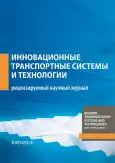Determination of operating parameters of toroidal field coils of a tokamak based on a high-temperature superconductor
- Authors: Aleksandrov D.A.1, Martirosian I.V.1, Vinitskiy E.A.1, Osipov M.A.1, Pokrovskii S.V.1
-
Affiliations:
- National research nuclear university MEPHI
- Issue: Vol 11, No 3 (2025)
- Pages: 409-421
- Section: Original studies
- URL: https://journal-vniispk.ru/transj/article/view/328152
- DOI: https://doi.org/10.17816/transsyst687274
- ID: 328152
Cite item
Full Text
Abstract
Aim: to determine the operating parameters of the toroidal magnetic field system (operating temperature, number of CORC cables, transport current value) of the MEPhIST-1 superconducting tokamak
Materials and Methods: numerical calculation of the toroidal magnetic field of a tokamak was performed in the COMSOL Multiphysics software
Results: magnetic field distributions were obtained for various values of the transport current flowing through the tokamak coil. The proportionality coefficients between the maximum magnetic field on the coil and the transport current, the operating magnetic field and the operating transport current were determined.
Conclusion: the number of CORC cables required to achieve an operating magnetic field induction of 1 T has been determined: 7 at a temperature of 37.6 K and 6 at a temperature of 33.6 K. It has been shown that it is possible to achieve an operating field value of about 1.5T with 7 CORC cables when the temperature is lowered to 21.1 K.
Keywords
Full Text
##article.viewOnOriginalSite##About the authors
D. A. Aleksandrov
National research nuclear university MEPHI
Email: cfrfcfrfdima123@gmail.com
ORCID iD: 0009-0001-7383-0094
SPIN-code: 5365-6190
research engineer
Russian Federation, MoscowI. V. Martirosian
National research nuclear university MEPHI
Email: mephizic@gmail.com
ORCID iD: 0000-0003-2301-1768
SPIN-code: 3368-8809
Cand. Sci. (Phys. Math.), research engineer
Russian Federation, MoscowE. A. Vinitskiy
National research nuclear university MEPHI
Email: egor.vinitsky@gmail.com
ORCID iD: 0009-0003-9462-5756
SPIN-code: 9216-7080
engineer
Russian Federation, MoscowM. A. Osipov
National research nuclear university MEPHI
Author for correspondence.
Email: max.vfk@gmail.com
ORCID iD: 0000-0002-8981-5606
SPIN-code: 4776-7939
research engineer
Russian Federation, MoscowS. V. Pokrovskii
National research nuclear university MEPHI
Email: sergeypokrovskii@gmail.com
ORCID iD: 0000-0002-3137-4289
SPIN-code: 6643-7817
Cand. Sci. (Phys. Math.), Head of the Laboratory
Russian Federation, MoscowReferences
- Muehlich P, Hamacher T. Global transportation scenarios in the multi-regional EFDA-TIMES energy model. Fusion Engineering and Design. 2009;84(7):1361–1366. doi: https://doi.org/10.1016/j.fusengdes.2008.12.016
- Lerede D, Saccone M, Bustreo C, et al. Could clean industrial progresses and the rise of electricity demand foster the penetration of nuclear fusion in the European energy mix? Fusion Engineering and Design. 2021;172. doi: https://doi.org/10.1016/j.fusengdes.2021.112880 EDN: BNAQQO
- Gao X, Zhang T, Wu M, et al. Recent results of fusion triple product on EAST tokamak. Plasma Science and Technology. 2021;23(9). doi: 10.1088/2058-6272/ac1165 EDN: RCDXUP
- Kim H-S, Jeon Y, Han H, et al. Development of high-performance long-pulse discharge in KSTAR. Nuclear Fusion. 2024;64(1). doi: 10.1088/1741-4326/ad0fbd EDN: YEFTYI
- Creely AJ, Greenwald MJ, Ballinger SB, et al. Overview of the SPARC tokamak. Journal of Plasma Physics. 2020;86(5). doi: 10.1017/S0022377820001257 EDN: XOIYOH
- Zhai Y, van der Laan D, Connolly P, Kessel C. Conceptual design of HTS magnets for fusion nuclear science facility. Fusion Engineering and Design. 2021;168. doi: https://doi.org/10.1016/j.fusengdes.2021.112611 EDN: RFOOXZ
- Molodyk A, Samoilenkov S, Markelov A, et al. Development and large volume production of extremely high current density YBa2Cu3O7 superconducting wires for fusion. Scientific Reports. 2021;11(1):2084. doi: 10.1038/s41598-021-81559-z EDN: FQXYLW
- Federici G, Siccinio M, Bachmann C, et al. Relationship between magnetic field and tokamak size—a system engineering perspective and implications to fusion development. Nuclear Fusion. 2024;64(3):036025. doi: 10.1088/1741-4326/ad2425 EDN: QJXQPS
- Zohm H. On the Use of High Magnetic Field in Reactor Grade Tokamaks. Journal of Fusion Energy. 2019;38(1):3–10. doi: 10.1007/s10894-018-0177-y
- Krat S, Prishvitsyn A, Alieva A, et al. MEPhIST-0 Tokamak for Education and Research. Fusion Science and Technology. 2023;79(4):446–464. doi: 10.1080/15361055.2022.2149033 EDN: ZIBZCH
- Gryaznevich M, Asunta O. Overview and status of construction of ST40. Fusion Engineering and Design. 2017;123:177–180. doi: https://doi.org/10.1016/j.fusengdes.2017.03.011 EDN: VDFVMW
- Kuteev BV, Azizov EA, Bykov AS, et al. Steady-state operation in compact tokamaks with copper coils. Nuclear Fusion. 2011;51(7). doi: 10.1088/0029-5515/51/7/073013 EDN: MWVEXC
- File J, Mills RG, Sheffield GV. Large Superconducting Magnet Designs for Fusion Reactors. IEEE Transactions on Nuclear Science. 1971;18(4):277–282. doi: 10.1109/TNS.1971.4326354
- Shafranov VD. Optimum Shape of a Toroidal Solenoid. Soviet Physics Technical Physics. 1973;17:1433.
- Vinitskiy EA, Ulasevich DL, Prishvitsyn AS, et al. Optimization of the Toroidal Magnetic Coil System for the Small Spherical Tokamak MEPhIST-0. Fusion Science and Technology. 2025;81(5):485–494. doi: 10.1080/15361055.2024.2431782
- Khodzhibagiyan HG, Novikov MS, Fisher EZ, Shemchuk AV. Concept of the High-Temperature Superconductor Magnetic System of the New Nuclotron Synchrotron. Physics of Particles and Nuclei Letters. 2024;21(1):68–72. doi: 10.1134/S1547477124010060 EDN: GOFBTG
- Alexandrov DA, Martirosian IV, Pokrovskii SV, et al. Energy capacity and energy losses of inductive energy storage device based on composite HTS tapes. Modern Transportation Systems and Technologies. 2024;10(2):215–230. doi: https://doi.org/10.17816/transsyst632274 EDN: LKEQV
Supplementary files














